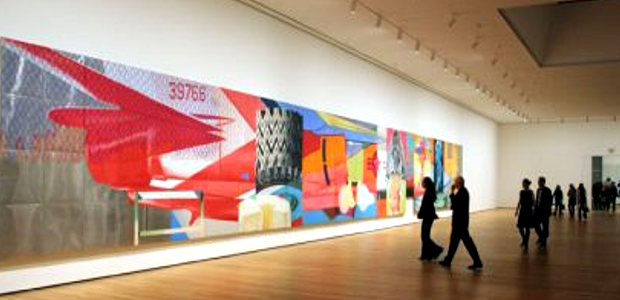Your login information returned multiple users. Please select the user you would like to log in as and re-type in your password.

If you follow me on Twitter you’ve probably noticed a plethora of tweets last weekend about a festival called Vector: Game + Art Convergence. It was a five day celebration in Toronto which entailed exhibits, performances, workshops and panel discussions between game art designers and academics. Vector wasn’t just a show about labelling video games as art, but an embrace of visual culture and a critical dialogue to open the gaming community to the academic and curatorial worlds.
Curating video games in a gallery or museum space is not a new concept. In late 2012, MoMA acquired 14 video games scheduled to be exhibited in the Phillip Johnson Galleries sometime this month. Their collection is a mixture between oldies like Pac-Man and modern examples like Portal, and while a lot of people applauded their move many were left outraged in the “high art” community. Whether or not video games classify as art is a discussion that has been done to death, but placing them in an exhibition space usually left for paintings, photography, or sculpture is an entirely different topic.
That wasn’t the case for Team Vector – composed of Skot Deeming, Clint Enns, Katie Micak and Christine Kim. Their collaborative efforts resulted in a large network of over 70 game designers, developers, academics, artists and musicians that used platforms, hardware, glitches, mods and hacks (just to name a few) to create contemporary game-based artworks. The festival was fascinating to be a part of even just as a spectator, and I wanted to bring forward discussions and issues inspired by the art and panels to the 4Player community. This first of three pieces of my feature will focus on the movement of video games into a high art curatorial space and the concept of gaming literacy. How are these two ideas related?
.png)
Part of my graduate studies deals with the idea of an artwork exhibition in a gallery or museum space, so combine that with video games and I am in my own heaven. The first exhibit of Vector titled Other Worlds was curated by Prosthetic Knowledge and mrghosty. It drifted through imaginary worlds to address psycho-geography and mental landscapes in a virtual space, sending the audience into psychedelic dreamlike environments. Each piece was accompanied with corresponding music that played through headphones as spectators interacted with the artwork. Before interacting myself, I stood back and observed the people playing. The atmosphere was serene as gamers absorbed the movements on the screen before them, and their interactions were identical to what you would see in an art museum. It was eye-opening to see gamers who are often cited for rage-quits and n00b-pwning online become so engaged in a piece the way a photography student would gaze at an original Man Ray.
Of course, there are several outlets for artistic games. Browse online and you will find a myriad of examples by indie developers that have received critical acclaim. Combine the existence of art games with the experience I just recalled and the result is a perfect candidate for an exhibition in a museum or gallery space. However gaining a spot in high art is more than just being able to produce quality work - there must be a way to read the work. Consider art historians or academics who have spent decades perfecting the literacy to better comprehend and discuss paintings, photography, and sculpture. How do gamers create a foundation of literacy to not only justify the spot of game-based artworks in the physical realms limited to high art, but interpret and theorize them as well?

This was a discussion question raised in one of the panels titled, "Games + Art: Play and Practice," where artists who are also game developers and designers discussed their relationship between the contrasting sides of their works. The panel seemed to agree that there was certainly a difference between the work they do commercially and independently, and not surprisingly what is required by the commercial industry producing AAA titles is not going to be based on any art structure. There was also a call to format a gaming rhetoric to not only define game art, but also how it can be significant and understood. While they spoke, a few questions popped into my head. If a gaming literacy is created for us to academically deconstruct how games fit in our cultural timeline - who writes it? Will it be important to the industry or just be a space solely for academia? The range of gamers is wide and not limited to basement-dwelling nerds or dude-bros, so how do we ensure that said literacy is accurate or fair?
I tweeted about the problem of creating an overall game literature and stated that literacy is an elitist concept, as is the exhibition space. What problems do you see with these concepts, if any? Can games reach the level of high art that will eventually produce a structured academic field of video game theory?




Comments
12 years, 4 months ago
Interesting Post,
You raise some very good questions in regards video games acceptance as an art form
I believe Games will one day reach the same level of esteem and appreciation as other more mainstream art, but until video games are accepted by the larger minority of the public I feel it will be a few years yet.
12 years, 4 months ago
"It was eye-opening to see gamers who are often cited for rage-quits and n00b-pwning online become so engaged in a piece the way a photography student would gaze at an original Man Ray."
What do you mean by that? Now I'm wondering what kind of people you saw at the event. Were they artsy looking people like the devs and showman? Or was it mostly average joes who play video games?
I'm a little more interested on what you got to play around with than the discussion of games in an "academic and curatorial world". Interesting read.
12 years, 4 months ago
Suspect you're right about the difficulty - even at an epistemological level - of developing a "gaming literacy". Digital culture is antithetical to canon-formation...there would always be some tension involved whenever anyone tried to enunciate authority in a gaming-art context. If a literacy did emerge, I get the feeling that it would be much more "market" based, or open-source in structure...something that might marginalize academic input. Questions of legitimacy (ie: the fairness and accuracy you've wondered about) would tend to rely on market-norms rather than academic insight (ie: the ol' upvote method) - which always creates problems when we want to think about art in critical ways.